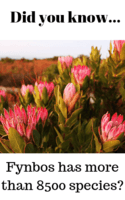Fynbos is Dutch for fine-leaved plants. Of the more than 8500 fynbos species, almost 6000 are indigenous. Fynbos is a unique kind of vegetation that makes up 80% of the Cape Floral Kingdom, with the majority found only in the Cape. Table Mountain alone has as many plants species as the United Kingdom – about 1500 species. This makes the Western Cape more botanically diverse than the richest rainforest in South America. Read more here
Fynbos includes: proteas, the king protea being the national flower of South Africa; ericas; restios; as well as geophytes; daisies; legumes and vygies. Buchu and rooibos are very popular as they are used for tea and restios are used for thatch. In 1735 Carl Linnaeus, the Swedish botanist, named the Protea after Protues, a mythological Greek God who had the ability to change his shape at will. Proteas are varied in form, size and habitat, just as the mythological Greek God was. Read more here
Fynbos is a UNESCO World Heritage Site and is protected as 1700 of the fynbos species are under threat of extinction by agriculture, invading plant species and human development. Fynbos will somehow adapt to climate change, but fynbos cannot handle alien trees. Trees that grow in similar environments as the fynbos overwhelm them and all the plant life dies. The alien trees’ seeds destroy the fynbos seeds ultimately eradicating it entirely.
As funny as it sounds Fynbos requires fire to survive. According to an article by The Fynbos Guy, What is Fynbos? An easy introduction: “… fynbos plants now require fire to complete their life cycle: the flames burn accumulated dead plant material to recycle nutrients back into the impoverished soil; the intense heat opens tightly-sealed seed-cones and triggers underground bulbs into growth.” Read more here Within a week new shrubs come back to life and the plant cycle takes its natural course once again.
Conserving fynbos is important. It promises the biodiversity of these mountains and provides us with a healthy and accessible natural environment. This huge array of plants also help with jobs and educational opportunities. Read more here
Fynbos helps to preserve water and allows for almost 80% of rainwater to run off the mountain and fill rivers and reservoirs. This really helped when the Western Cape was suffering from the terrible drought.
Fynbos appears unimpressive from a distance. It is treeless, scrubby and not particularly attractive. It just looks like plain old bush. But once you look closer, fynbos showcases a spellbinding show of plants bursting with flowers every month of the year.
If you find yourself in the Cape region, then be sure to visit Kirstenbosch botanical garden that hosts a wide range of the fynbos species or take a hike on Table Mountain.
Tell us: What did you find most interesting about Fynbos?

